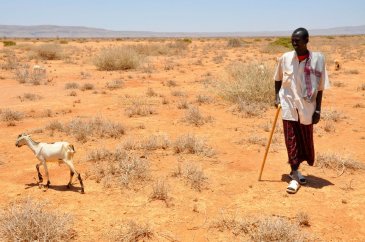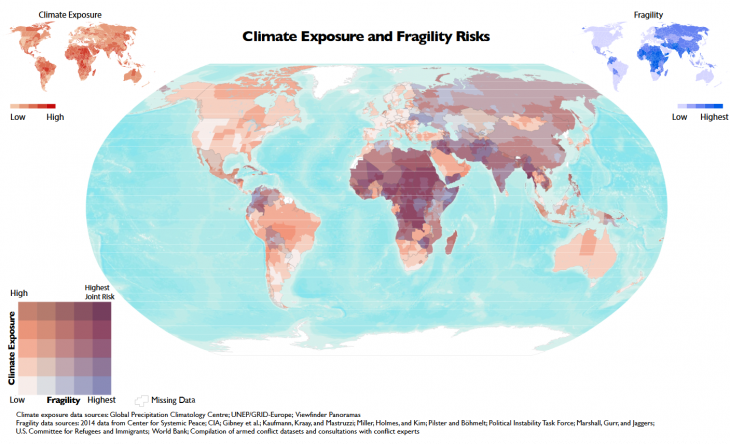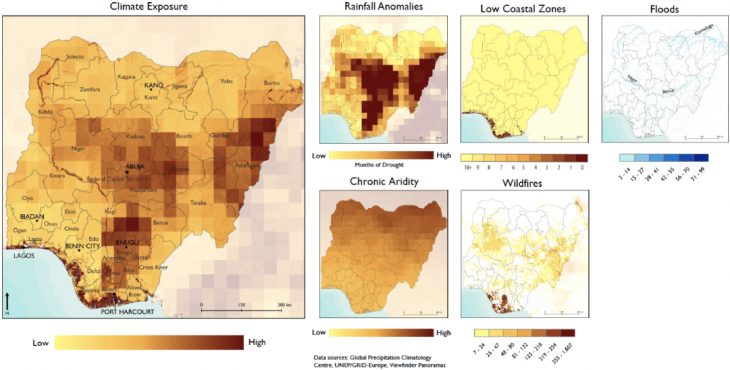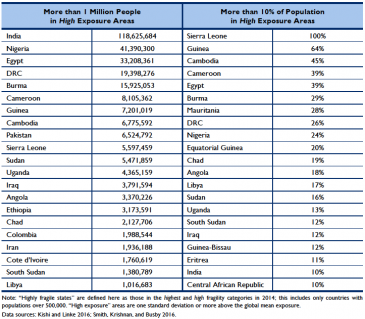With its population of more than 190 million, Nigeria’s fate is central to the success of West Africa. Armed opposition groups like Boko Haram have plagued the north of the country for years — spilling over and destabilizing neighboring countries — and violence involving Fulani militias in the Middle Belt reached an all-time high this year. Nigeria’s government has struggled to contain these conflicts and address the needs of its population.
At the same time, the country faces extensive climate-related pressures, from chronic aridity and flooding in the north to rainfall anomalies in the middle of the country to heavy flooding and wildfires in the densely populated south.

Photo: Oxfam East Africa
Nigeria is just one of many states facing the double burden of state fragility and climate exposure, which is the subject of our new report for the U.S. Agency for International Development (USAID). State fragility reflects poor state capacity and poor state-society relationships, both of which can contribute to instability. Climate exposure reflects the risks to a state’s people and land stemming from climate hazards like cyclones, floods, droughts, coastal inundation, and wildfires.
With the evidence on causal links between climate change and conflict contested, more fruitful research has turned to examining indirect pathways between climate stress and security outcomes — through factors like economic growth, food prices, and migration. Considering state fragility in this analysis is crucial because a government’s ability to manage economic and social processes can impact whether a population becomes more — or less — vulnerable to the climate risks it faces. By assessing how climate and fragility risks intersect, we can identify how poor state capacity and poor state-society relationships make vulnerability worse. Conversely, we can also identify where resilience efforts — building capacity to recover from shocks and stresses — can advance climate, governance, and conflict prevention goals simultaneously.
In countries with high combined state fragility and climate risks, policies promoting peace, stability, and resilience should be designed to positively reinforce each other and reduce both sets of risks that can contribute to instability. Such an approach could include: improving perceptions of government legitimacy — thus reducing overall fragility — through timely and effective responses to climate risks; directing climate responses through areas of governance where the state has the strongest capacity to act; investing in institutional changes to reduce overall state weakness in countries affected by sustained conflict and build those governments’ ability to address climate risks; and shoring up the capacity of states with high climate risks before they become more fragile.
Why Assess Fragility and Climate Risks Together?
Climate change poses a multi-faceted and increasingly urgent security threat for fragile states. Risks to the population can force governments to redirect scarce resources to adaptation or humanitarian response efforts and strain the capacity of already fragile states. The pressing need to address the intersection of fragility and climate risks is underscored in the recent report from the Intergovernmental Panel on Climate Change, which concludes that the impacts of climate change are evident and growing — and will be felt hardest by developing countries.
Places experiencing combined fragility and climate risks may be more vulnerable to humanitarian crises and instability. Already, more military and aid interventions have occurred in fragile states experiencing localized conflict, political upheaval, and humanitarian crises — many of which also face high climate risks. Of the 26 countries that today have the highest compound fragility and climate risks, the United Nations has peace operations in 20, the U.S. military has troops deployed in all but four, and the U.S. government has provided $97.8 billion in security, humanitarian, and development aid over the last 10 years (30 percent of its aid to all countries globally). Yet policymakers have not had systematic information to plan and prioritize their investments in these areas where fragility and climate risks intersect, prompting the G7 to call for such an assessment in 2015.
Our work seeks to identify where these combined risks exist and how they vary from place to place. Using USAID guidance, we tracked two dimensions of state fragility — effectiveness and legitimacy — in the security, political, economic, and social spheres to rank countries’ fragility from lowest to highest. Then, drawing on our previous research for the Defense Department’s Minerva Initiative on climate security hot spots in Africa and Asia, we created a global index of physical exposure to climate hazards. The resulting maps, global rankings, and subnational metrics can help identify the places of potential concern for these compound fragility and climate risks.
Where Do Fragility and Climate Risks Intersect?
The highest combined fragility and climate risks are concentrated in sub-Saharan Africa, with the remaining areas dotted across the Middle East and North Africa, South and Southeast Asia, and a few parts of South America (see Figure 1).

Figure 1. Global Combined Fragility and Climate Risks
Most highly fragile states — 26 of the 39 states with the highest or high fragility — have chronic, high exposure to multiple climate hazards, facing some combination of floods, wildfires, chronic aridity, rainfall anomalies, cyclones, and coastal inundation. For a highly fragile state — like Nigeria, which faces substantial risks from both slow-onset hazards like droughts and rapid-onset hazards like floods and wildfires (shown in Figure 2) — these diverse threats and required responses can exceed state capacity.

Figure 2. High Exposure to Multiple Climate Hazards in Nigeria
All 26 states with high compound fragility and climate risks have more than 1 million people or more than 10 percent of the population living in high-exposure areas. 17 of these are in Sub-Saharan Africa,

Table 1. Highly Fragile States with Large Populations in High-Exposure Areas
four in the Middle East and North Africa, four in South and Southeast Asia, and one in South America. India stands out with more than 118 million people in high–exposure areas, followed by Nigeria with 41 million, Egypt with 33 million, and the Democratic Republic of the Congo with 19 million. In terms of the share of population affected, Sierra Leone stands out with 100 percent of its population living in high–exposure areas, followed by Guinea with 64 percent, Cambodia with 45 percent, and Cameroon and Egypt with 39 percent each (see Table 1).
Implications of Compound Risks: The Case of Nigeria
Nigeria experiences among the highest compound fragility-climate risks. More than 41 million Nigerians (24 percent of the population) live in high-exposure areas. Longstanding environmental stress coupled with poor government management contributes to the current instability from several food crises and land conflicts, risking a dangerous feedback loop between fragility and climate challenges.
The crisis in Nigeria’s north, for example, reflects chronic emergency conditions and famine risks that are not caused by climate factors alone. While the north experiences chronic aridity and high overall climate exposure, its overall exposure levels are not the highest in the country (as Figure 2 shows). The famine risk appears to be primarily driven by continued political violence disrupting harvests and aid supplies rather than by climate factors alone. This suggests that the challenge here is not necessarily that climate stress is insurmountable, or that local agricultural approaches and foreign aid responses are ineffective. Rather, particular aspects of the state’s fragility — in this case, the government’s inability to maintain security or address the political and socioeconomic issues that lead to conflict — are undermining resilience.
Crises in other parts of Nigeria likewise have both climate- and fragility-related components. Rural violence in the Middle Belt involves a highly climate-stressed region where the state has provided only limited responses to growing food insecurity, cattle rustling and other criminal activity, and ongoing communal tensions between Fulani herders and non-Fulani farmers over the use of land and water resources. Simmering tensions in the climate-stressed Niger Delta reflect a longstanding secessionist movement driven in large part by disputes over state management of oil revenues, deteriorating environmental conditions, and economic development challenges.
Nigeria’s concurrent crises in the north, Middle Belt, and Niger Delta show how combined fragility and climate risks can heighten populations’ insecurity by increasing their vulnerability to humanitarian emergencies and violence. Climate stress alone does not cause or lead inexorably to the emergency conditions and violence these regions face. Instead, populations facing high climate stress have been made more vulnerable by limited state capacity to address underlying political and socioeconomic issues that foster conflict and to prevent violence from disrupting adaptation efforts and livelihoods. This underscores the idea that a complete picture of climate vulnerability only emerges with an assessment of the state’s capacity to respond to interrelated environmental, social, economic, and security dynamics.
What Can Be Done?
Examining compound fragility-climate risks provides a more complete understanding of a state’s vulnerability and resilience. This can offer a broader set of strategies for reducing fragility and mitigating climate risk. Our findings highlight at least four opportunities for action.
First, addressing climate risks in fragile states could both enhance resilience and reduce fragility. Poor state legitimacy — that is, public perceptions that the state is unable or unwilling to meet public needs — contributes more to the fragility of states, on average, than poor state effectiveness does. This trend is even more pronounced in states with high compound fragility-climate risks, like Nigeria. Thus, there is potential for states to simultaneously reduce climate risks and increase their legitimacy by taking actions that respond to the public’s need for reduced climate vulnerability.
For example, building state capacity to address flood and drought risks can make these events less deadly and less costly over time. This improves resilience to these specific climate hazards while also reducing their impact on agricultural yields and the population’s economic security. When all affected populations benefit from government efforts to prevent and manage floods and droughts, it can improve state effectiveness in meeting public needs and perceptions of state legitimacy.
Second, in states experiencing sustained conflict, institutional reforms in the political sphere are critical to reduce state weakness and strengthen the government’s overall ability to respond to climate risks. Several states with high climate exposure and high fragility (the Democratic Republic of the Congo, Nigeria, Pakistan, and Sudan) are embroiled in multiple long-term conflicts that both reflect and contribute to deep weaknesses in state capacity. These conflicts will make it harder to effectively address climate risks without building an institutional capacity to meet public needs and address the underlying issues that led to conflict.
Nigeria, for example, has made modest gains in building state economic capacity. Yet conflict has disrupted food production for years, making it harder for the government to improve resilience in its agricultural sector and reduce dependence on food imports, which in turn harms food and economic security. Thus, even in countries making some improvements in governance, security problems can undermine the government’s overall ability to prepare for (even near-term) future risks. This is particularly evident on crosscutting issues like climate change that require integrated planning across sectors. A coordinated approach and institutional reforms are thus critical to reduce interrelated fragility and climate risks, lest improvement in mitigating one risk be undermined by lack of improvement in the other.
Third, climate responses will have the best prospects for success when they are directed through areas of governance where the state has the strongest capacity to act. Many high-risk states have improved their effectiveness in specific spheres in recent years, even while enduring high fragility due to poor or worsening state legitimacy. In contrast to states where capacity is lacking across the board, these states have been steadily building capacity in their areas of strength, laying the groundwork for more effective climate policies.
Colombia, for example, experiences high fragility, stemming from persistent violence and very high climate exposure concentrated in small portions of the country. Yet Colombia does have strong state capacity in the political and social spheres. As such, the country can draw on its political institutional capacity to adopt — and its social service capacity to implement — policies aimed at preventing climate hazards from becoming disasters. In the country’s south, flash flood risk is exacerbated by city expansion into floodplains, particularly with the arrival of people displaced by conflict, and by lack of regulation over settlement and deforestation. In this region, zoning and planning policies tailored to these risks could reduce the population’s vulnerability.
Similarly, Ethiopia has high fragility in some spheres, but its strong political institutions have helped the country navigate its considerable climate challenges. In 2015 and 2016, when Ethiopia experienced its worst drought in 50 years, the country was able to use its strong political institutions to avert famine through food and cash assistance, among other measures. In the wake of the drought, a protest movement by the Oromo people led to violent clashes, and the country’s prime minister stepped down. On some level, both the state’s response to the drought and the political transition resulting from civil strife provide hopeful signs that countries facing twin climate and fragility challenges can navigate them by using existing institutions that are relatively strong.
Fourth, prevention efforts should focus on shoring up the capacity of states with high climate risks before they also begin experiencing high fragility. States like Bangladesh, China, Ecuador, the Philippines, Russia, and Venezuela are only moderately fragile, but many of their people face very high climate exposure. Climate hazards place extreme stress on these states, which are already struggling on the fragility side. If fragility worsens, and these states cannot effectively address their climate risks, large numbers of people could become even more vulnerable.
Bangladesh, for instance, has some of the largest numbers of people facing high climate exposure. The country has improved its governance capacity in the social and economic spheres and done an effective job preparing for climate hazards, making its exposure to cyclones and floods less deadly. However, the aspects of fragility that persist — namely sustained political turmoil and increasing violence — are already producing instability and could undermine continued progress in addressing climate challenges in the future.
Moving Forward
Any global mapping and data effort has limitations. National fragility measures do not capture nuances and differences at the subnational level, while climate hazard measures provide detailed subnational data but not a complete portrait of all climate risks or populations’ vulnerability to those risks. We see our maps and data as a starting point that identifies where these two sets of risks intersect and what aspects of a state’s fragility could impact its ability to address climate risks. Applications by practitioners in specific countries should be informed by more nuanced ground-level observations.
Setting aside whether, or to what extent, climate factors cause conflicts, the reality is that climate hazards and state fragility are double burdens that a number of countries face. Climate hazards are a drag on development and security, while security problems can exacerbate climate risks. The upside of this linkage, however, is that addressing climate risks can help improve government effectiveness and legitimacy, and vice versa. Policies that account for these intersecting risks can create greater odds of success for climate policies and for high-impact interventions that advance climate, governance, and conflict prevention goals simultaneously. While more work needs to be done on the proper sequencing of policies, we hope identifying the co-location of climate hazards and state fragility will help practitioners identify geographies of concern and pathways for progress.
- This text was first published at the War on the Rocks blog 20 November 2018
- Ashley Moran is Director of the State Fragility Initiative at the Robert Strauss Center for International Security and Law at the University of Texas at Austin; she previously led democratic reform programs in Iraq and the former Soviet Union.
- Joshua Busby is Associate Professor at the LBJ School of Public Affairs at the University of Texas at Austin, a Distinguished Scholar at the Robert Strauss Center for International Security and Law, and a Senior Research Fellow at the Center for Climate and Security.
- Clionadh Raleigh is Executive Director of the Armed Conflict Location and Event Data Project (ACLED) and Senior Professor of Political Geography in the School of Global Studies at the University of Sussex.
- The study’s reports, data, and maps — including data sources referenced in this article — are available here.
Leave a Reply